Abstract
1. Small 'step' or sinusoidal displacements were imposed on the mandible while human subjects maintained an average biting force of 10 N. Phase-related changes in the force resisting sinusoidal displacement were used to determine the mechanical stiffness of the human mandibular system as a function of the frequency of stretching. 2. Jaw-muscle electromyographic (e.m.g.) responses to 'step' stretches were of 8 msec latency and generated a very substantial force response. Jaw-muscle e.m.g. responses having longer latency were not observed. 3. The mechanical stiffness of the human mandible was relatively constant as a function of the frequency of stretching, having a typical magnitude of about 15 N/mm (+/- 200 micrometers stretch) or 10 N/mm (+/- 1500 micrometers stretch) at mean biting forces of 10 N. The force resisting displacement was phase-advanced at all frequencies. 4. Modulation of jaw muscle electrical activity evoked by sinusoidal stretches increased in amplitude as a function of increasing stretch frequency. E.m.g. modulation was 60--100 degrees advanced at frequencies of 1--10 Hz, but the phase decreased at higher frequencies, becoming negative (lagging stretch) at frequencies of 30 Hz and above. These characteristics are consistent with the idea that the jaw stretch reflex is dependent on jaw muscle spindle afferent fibres exciting jaw-closing motoneurones by relatively direct (but not necessarily monosynaptic) connexions. 5. The relationship between jaw-muscle activity and voluntary fluctuations of isometric biting force suggests that human jaw muscles can be modelled as a second-order linear 'filter'. The corner frequency for human jaw muscle is about 3 Hz; thus it would appear to be considerably slower than jaw muscle of monkeys. 6. The reflex stiffness of the human mandible, estimated quantitatively on the assumption that human jaw muscle stiffness is similar to the intrinsic stiffness of the gastrocnemius of the cat, ranges between 5 and 9 N/mm at frequencies between 1 and 8 Hz. Since this reflex stiffness is about the same as muscle stiffness in this frequency range, we conclude that the stretch reflex of the human mandible contributes functionally to its postural stability. 7. Reflex stiffness appears to be greater in the monkey mandible relative to muscle stiffness than in the human mandible. The difference is argued to be a manifestation of the difference in jaw muscle contraction speed between the two species. 8. The fact that the mandibular stretch reflex appears to be stronger than the stretch reflex of the limbs of intact animals and humans is discussed in terms of the special anatomical and functional features of the mandible.
Full text
PDF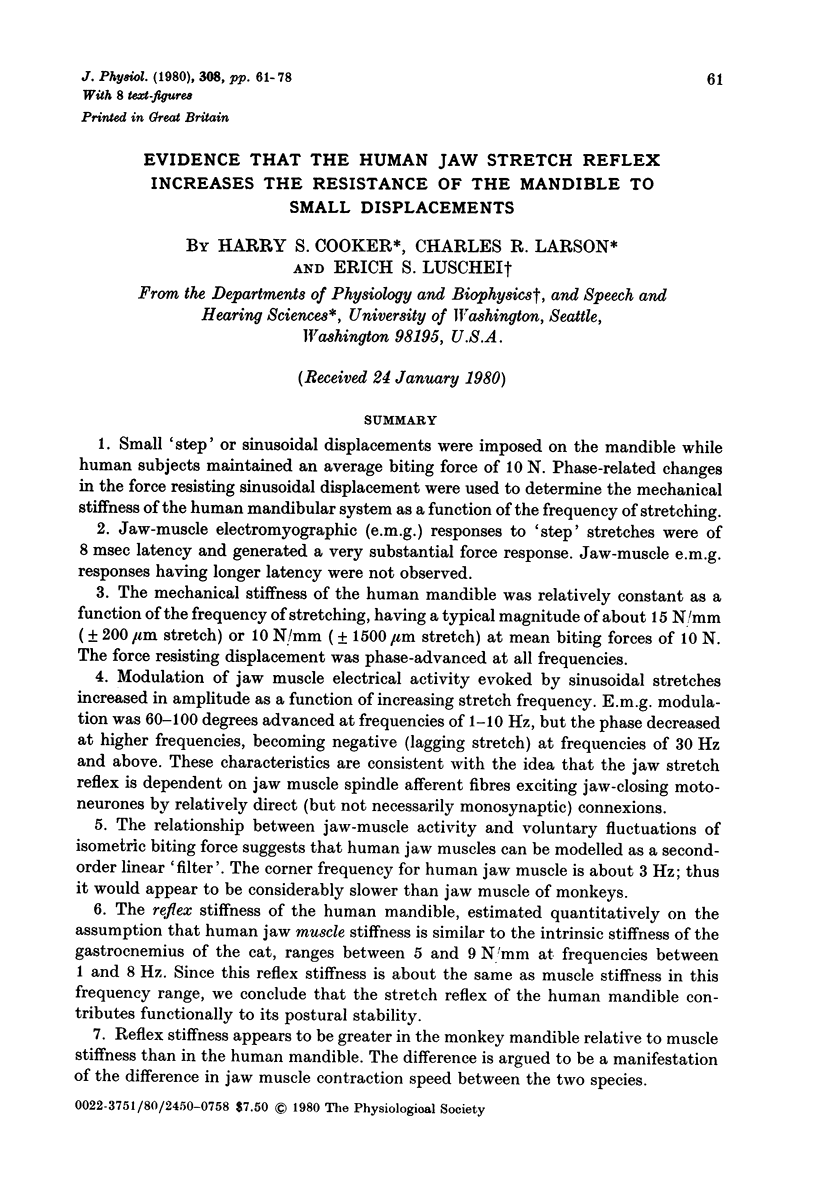
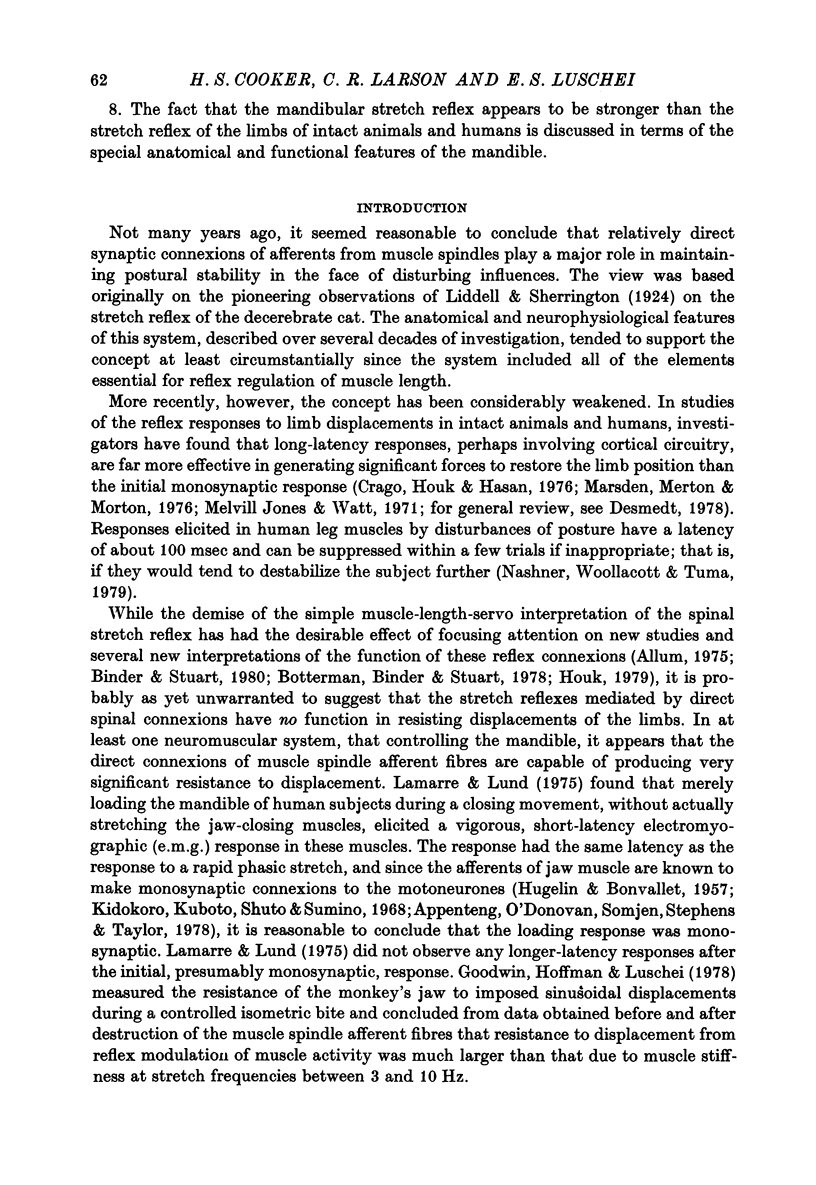
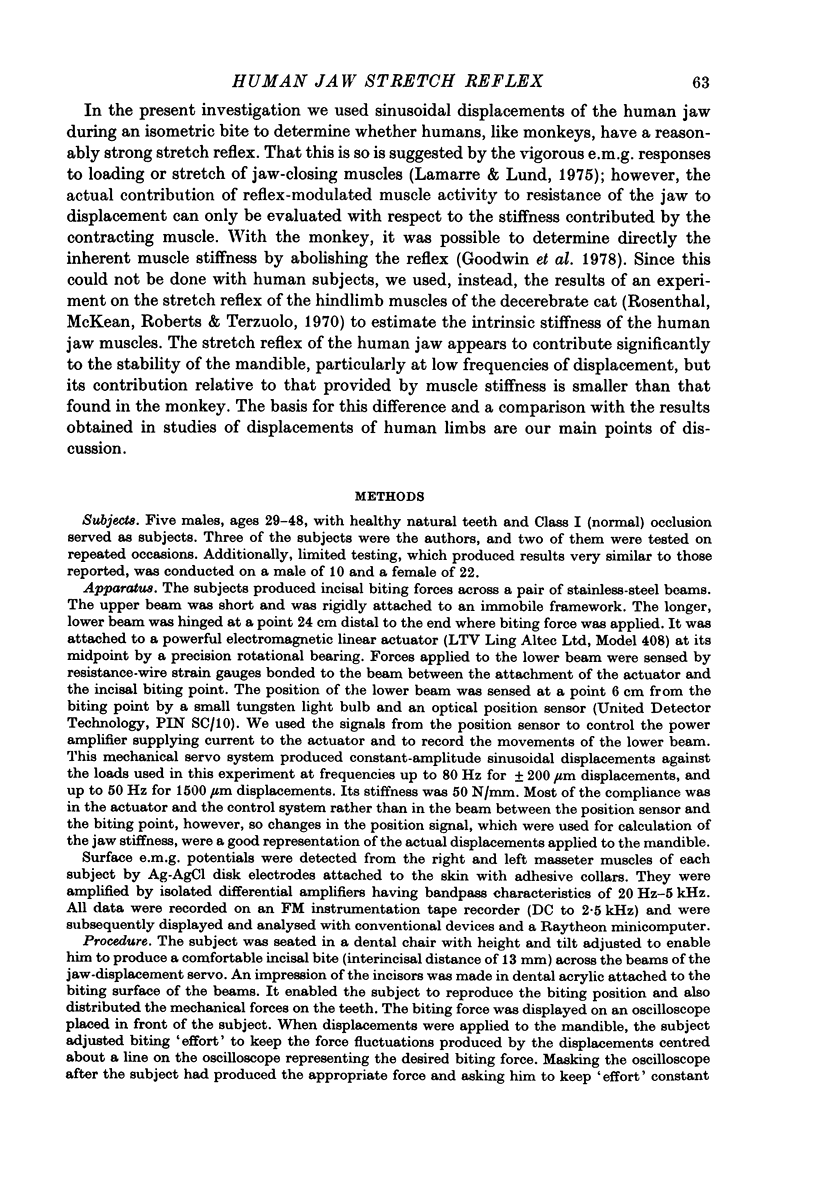

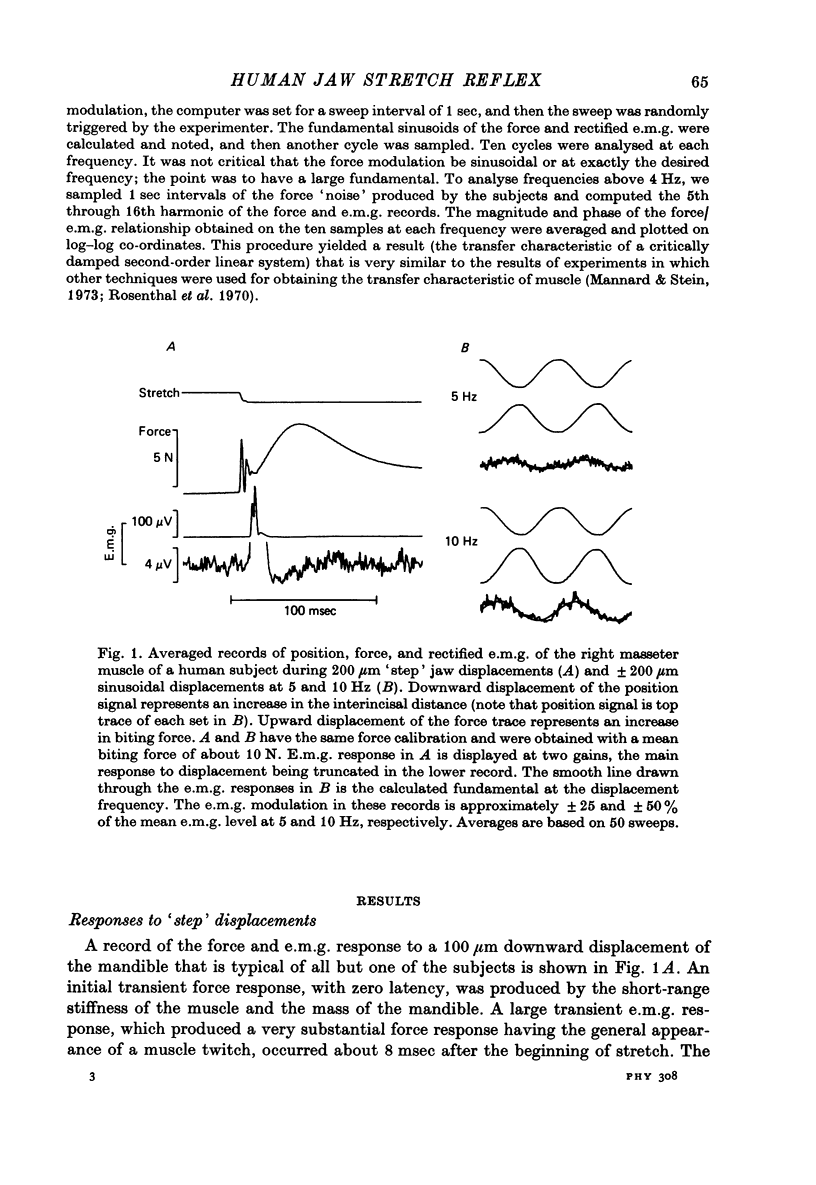
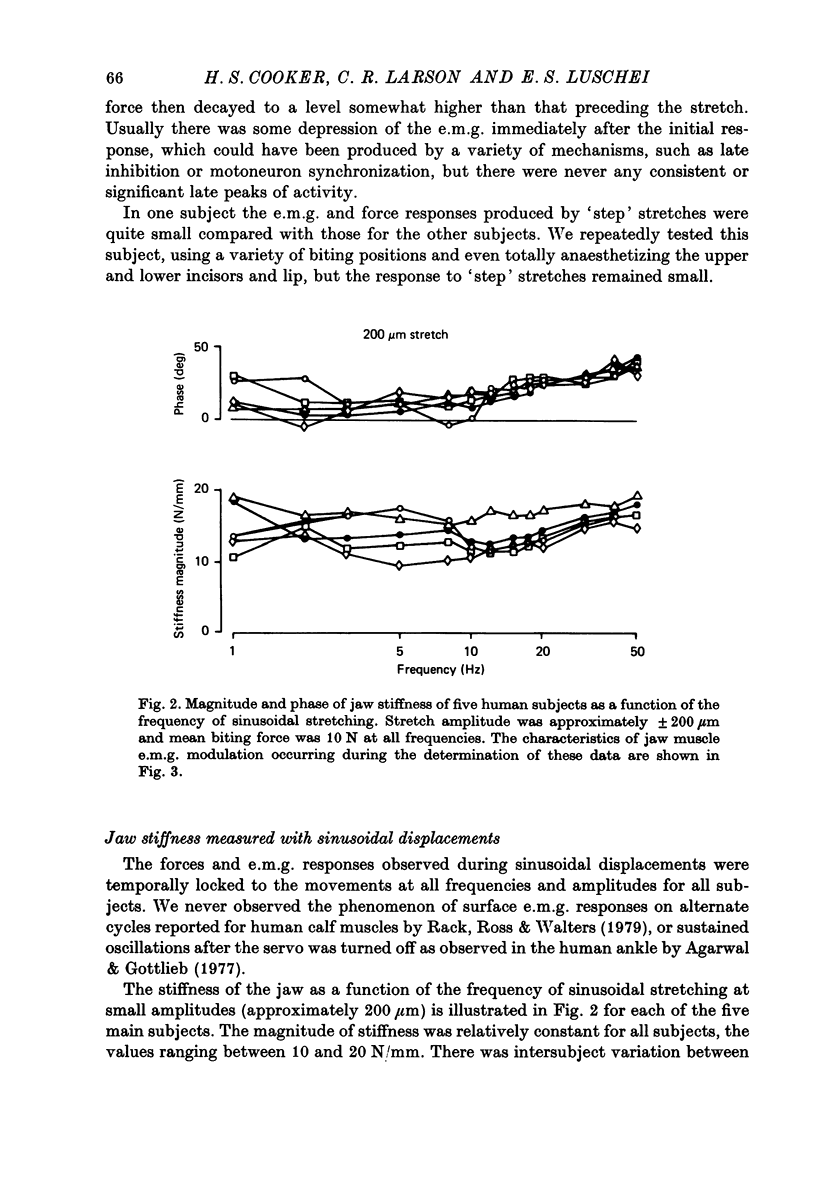
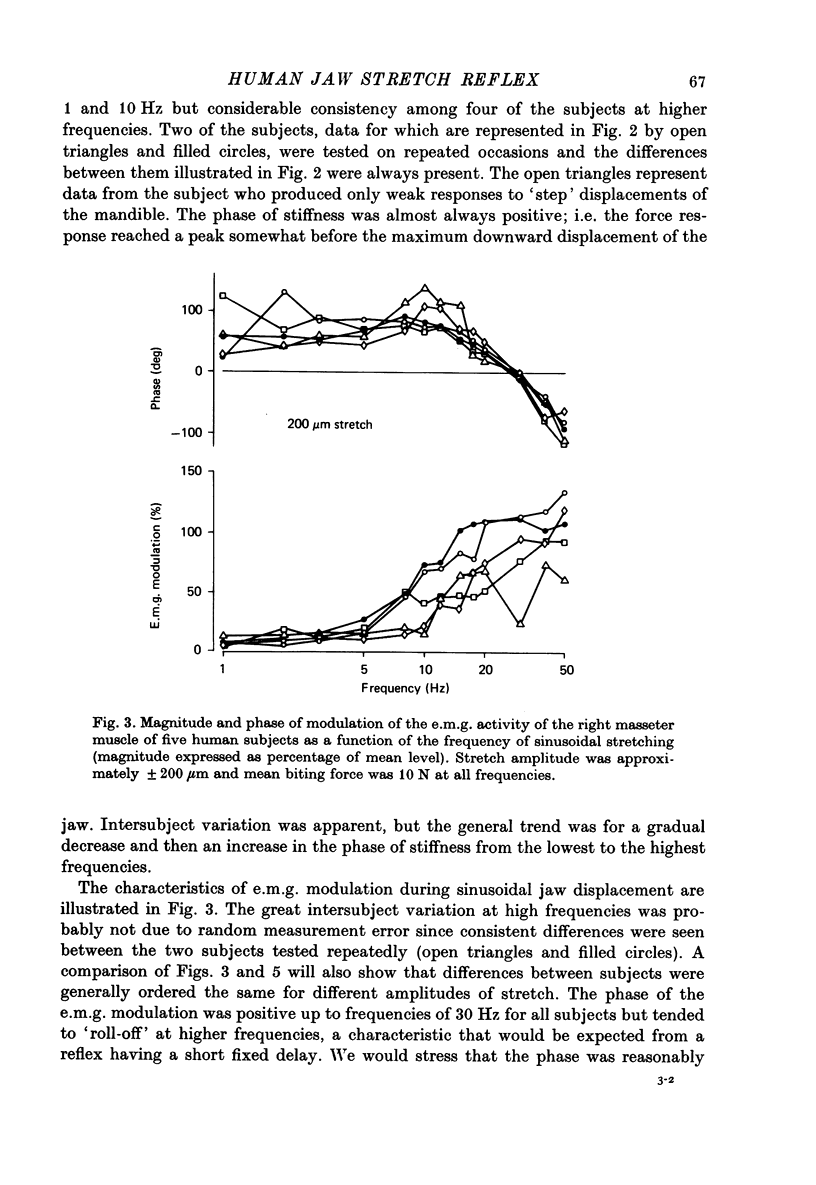
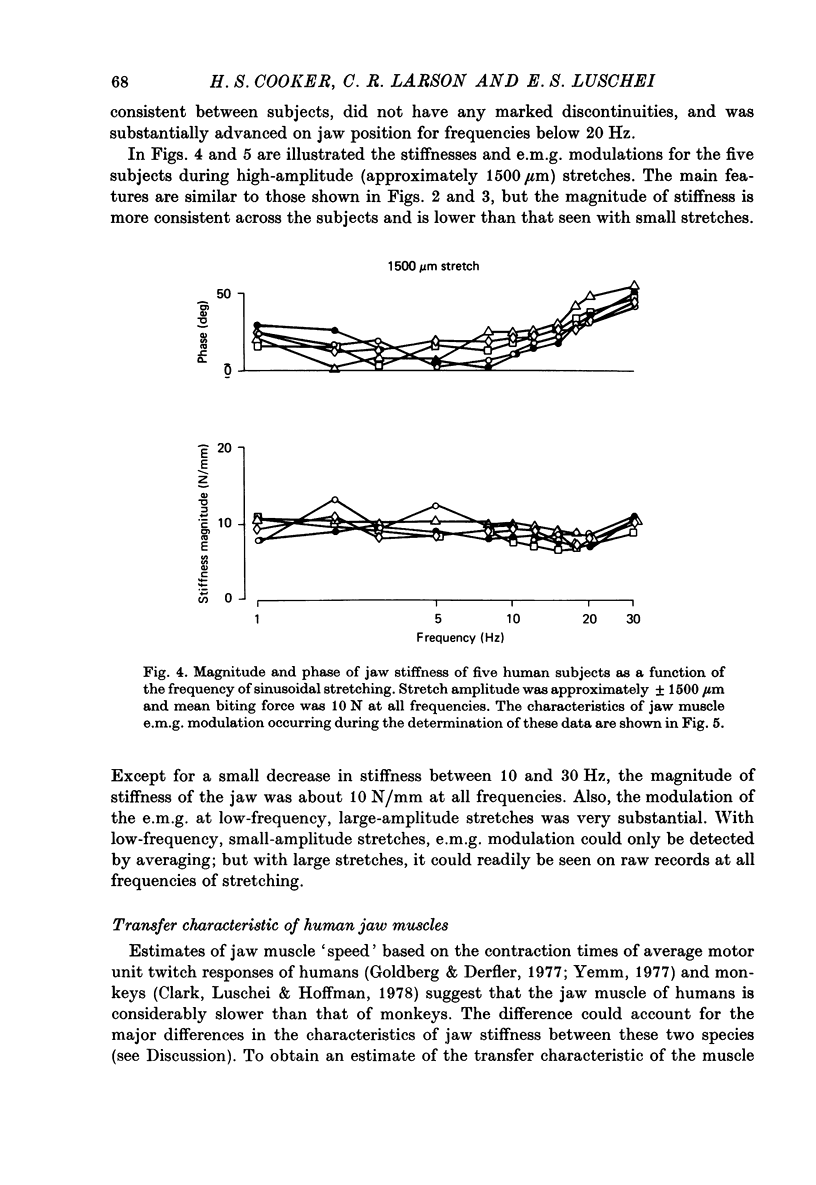
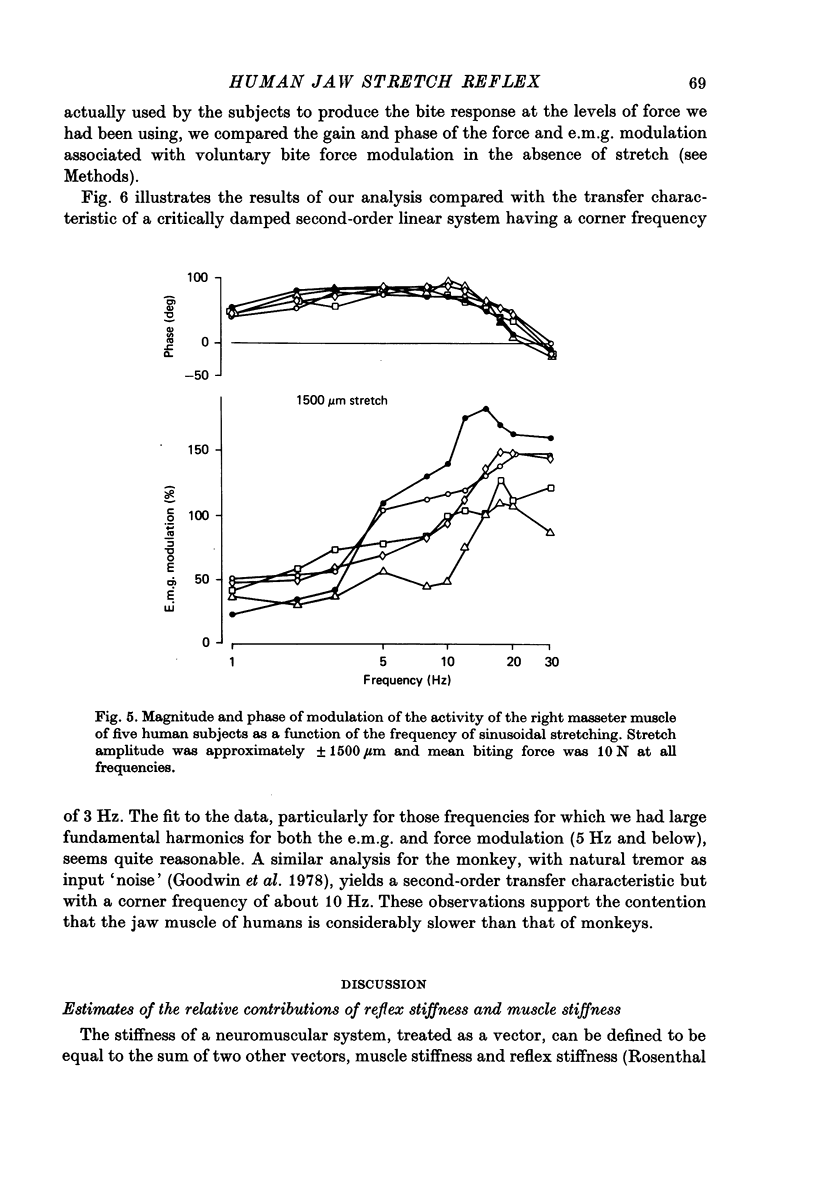
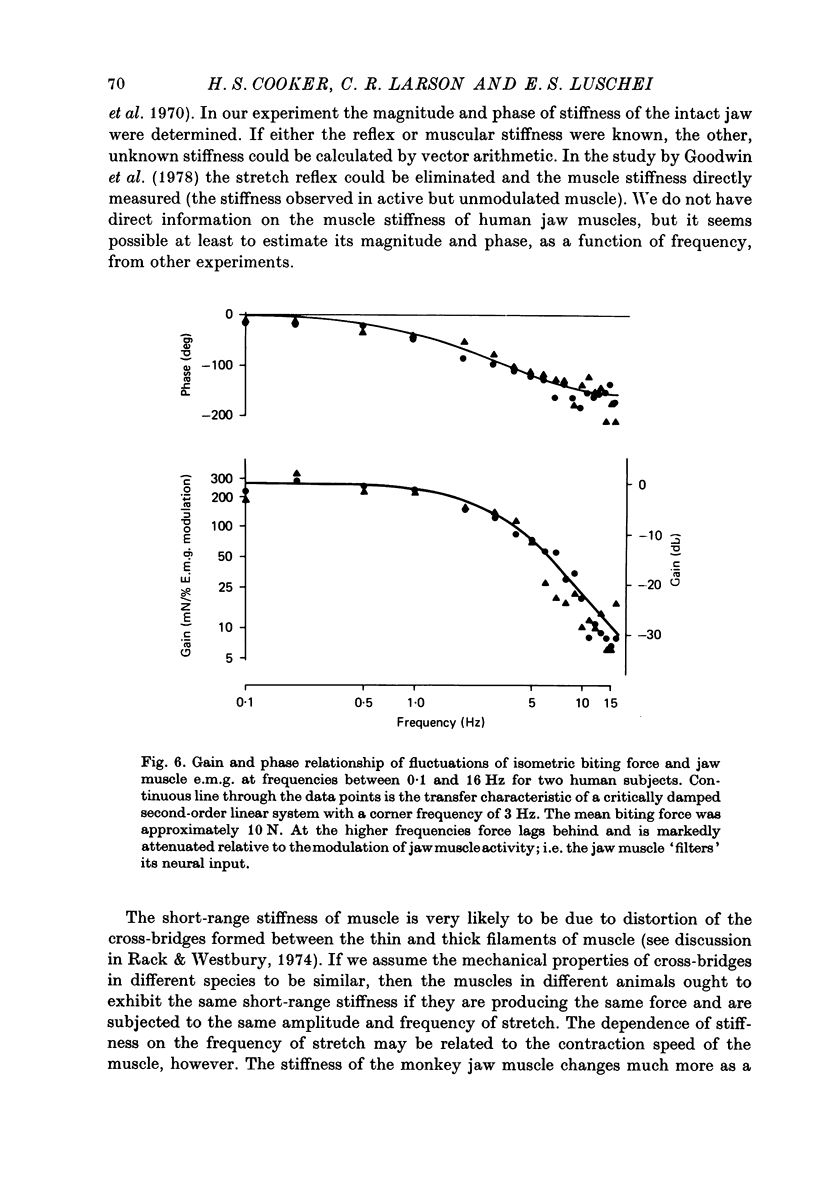
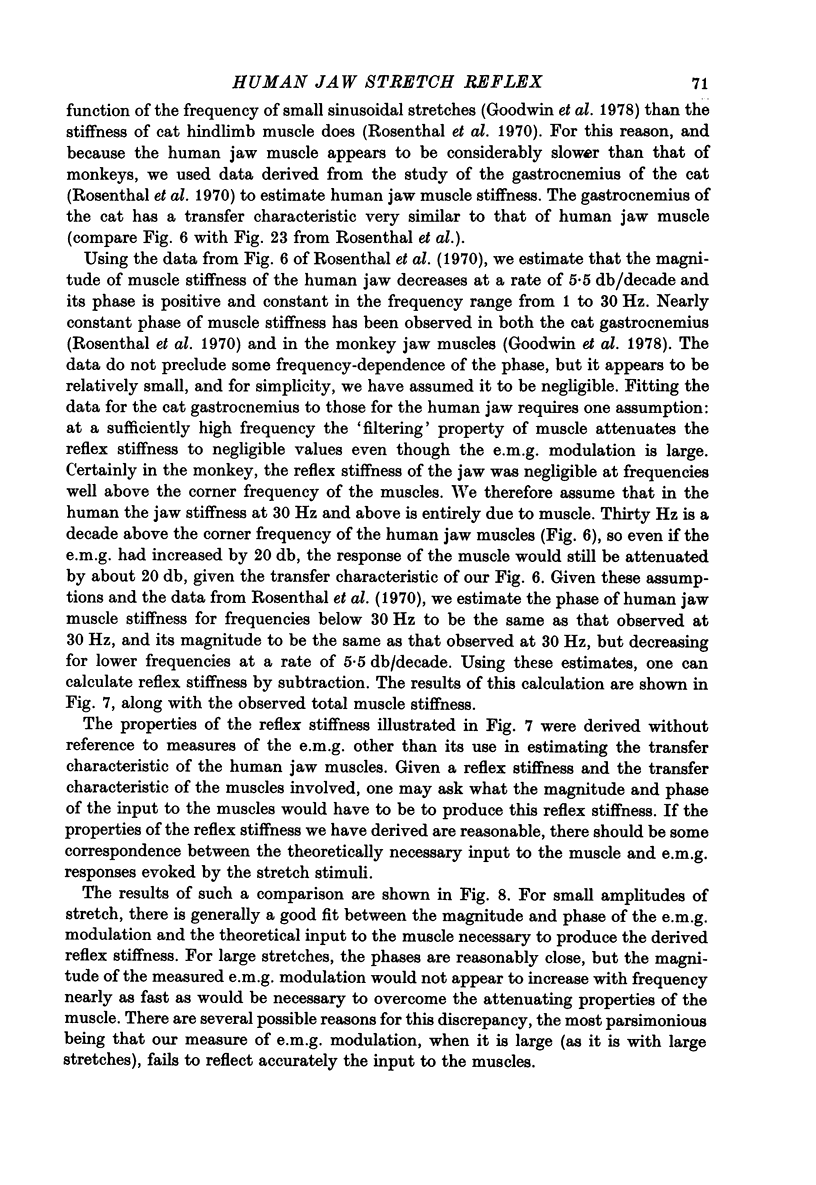
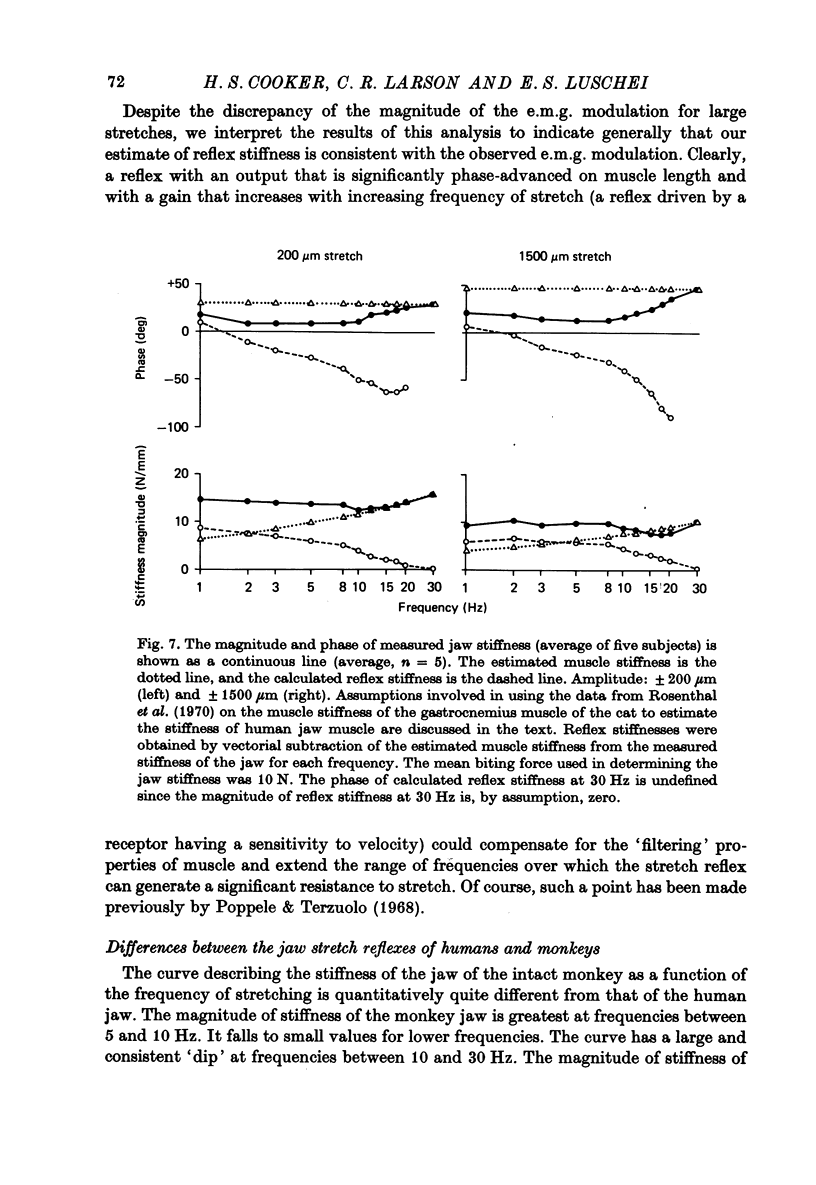
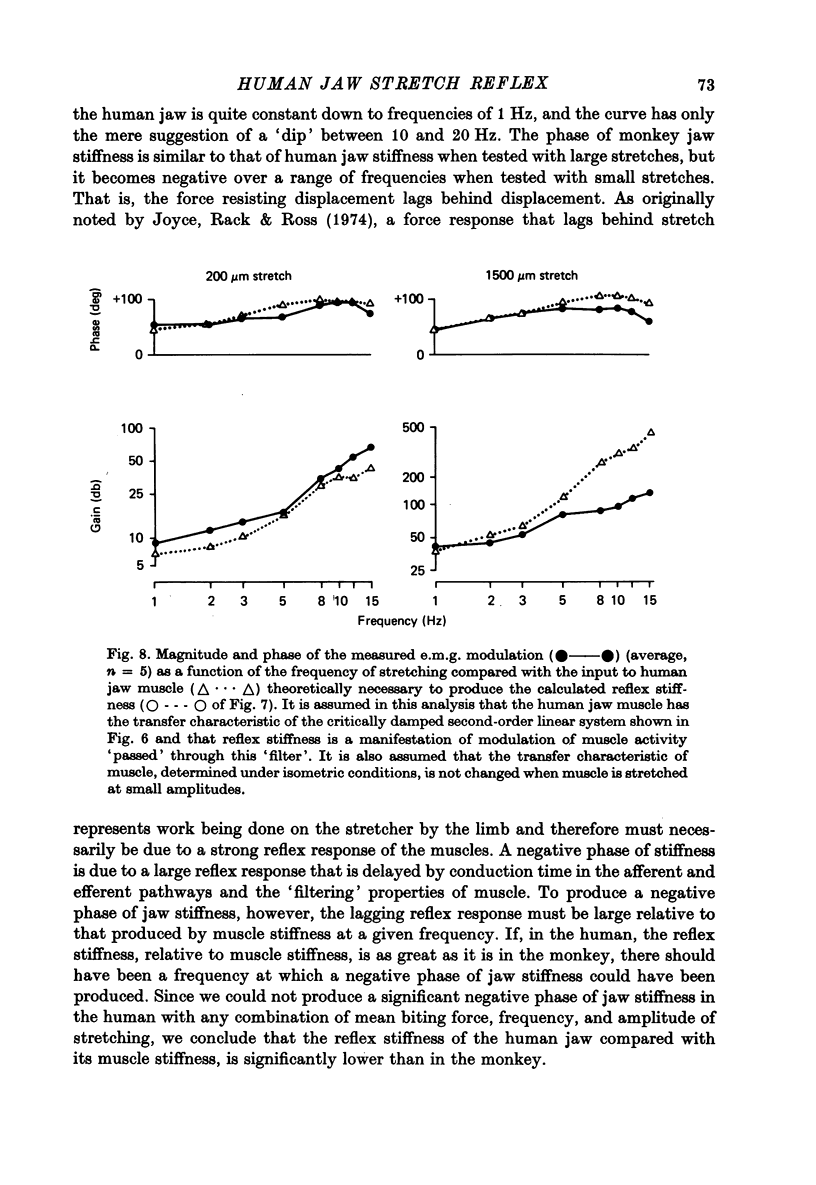
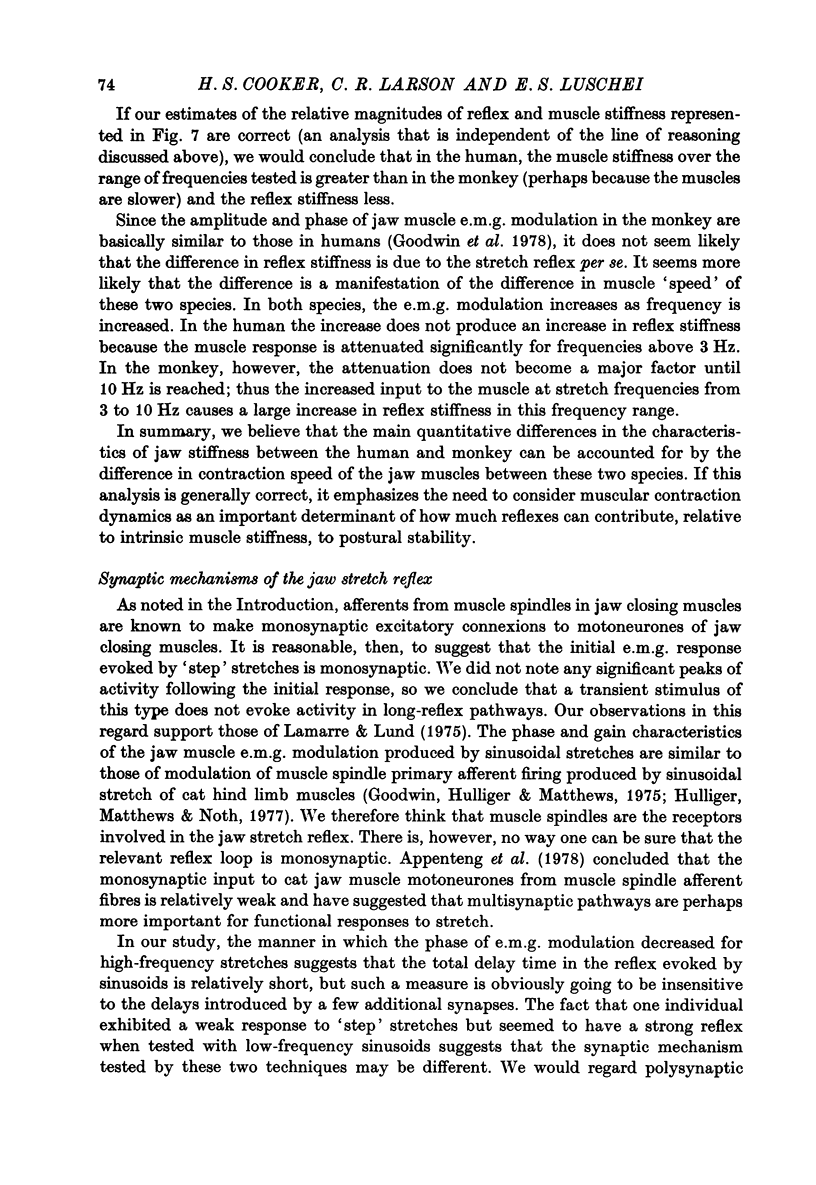
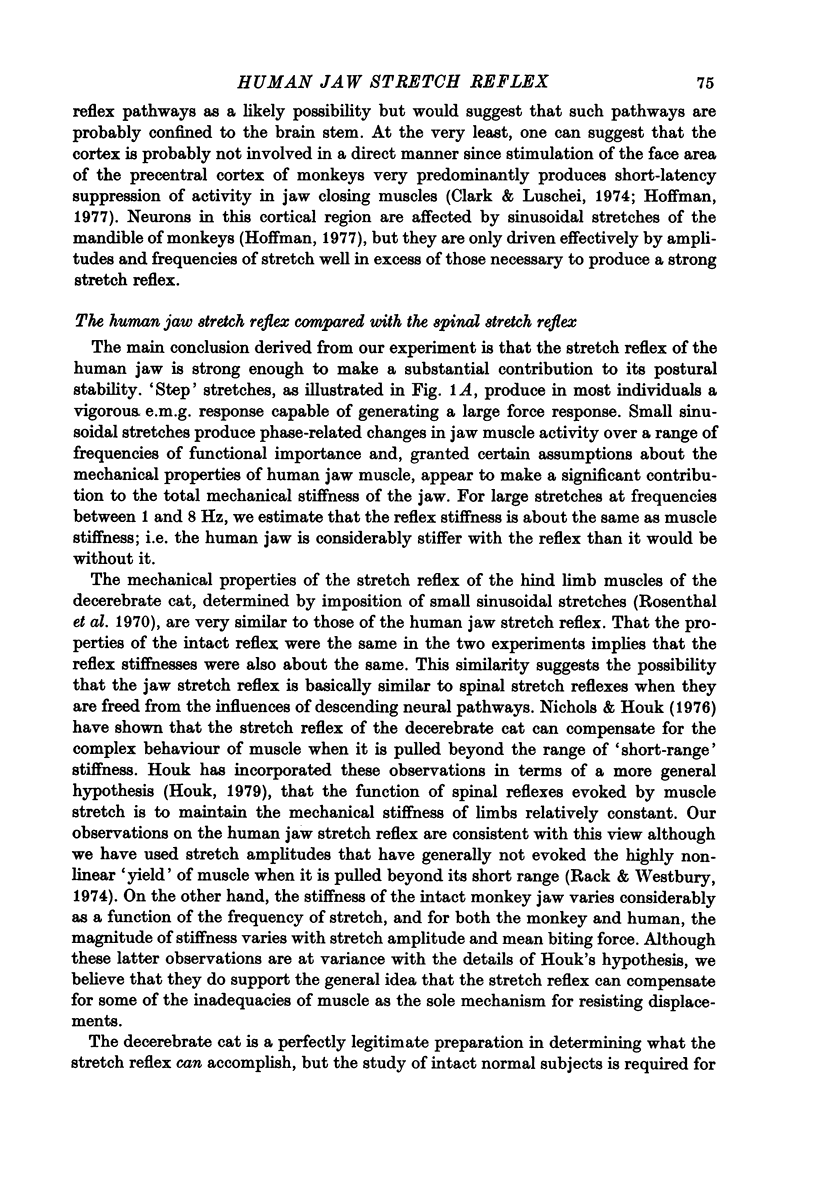
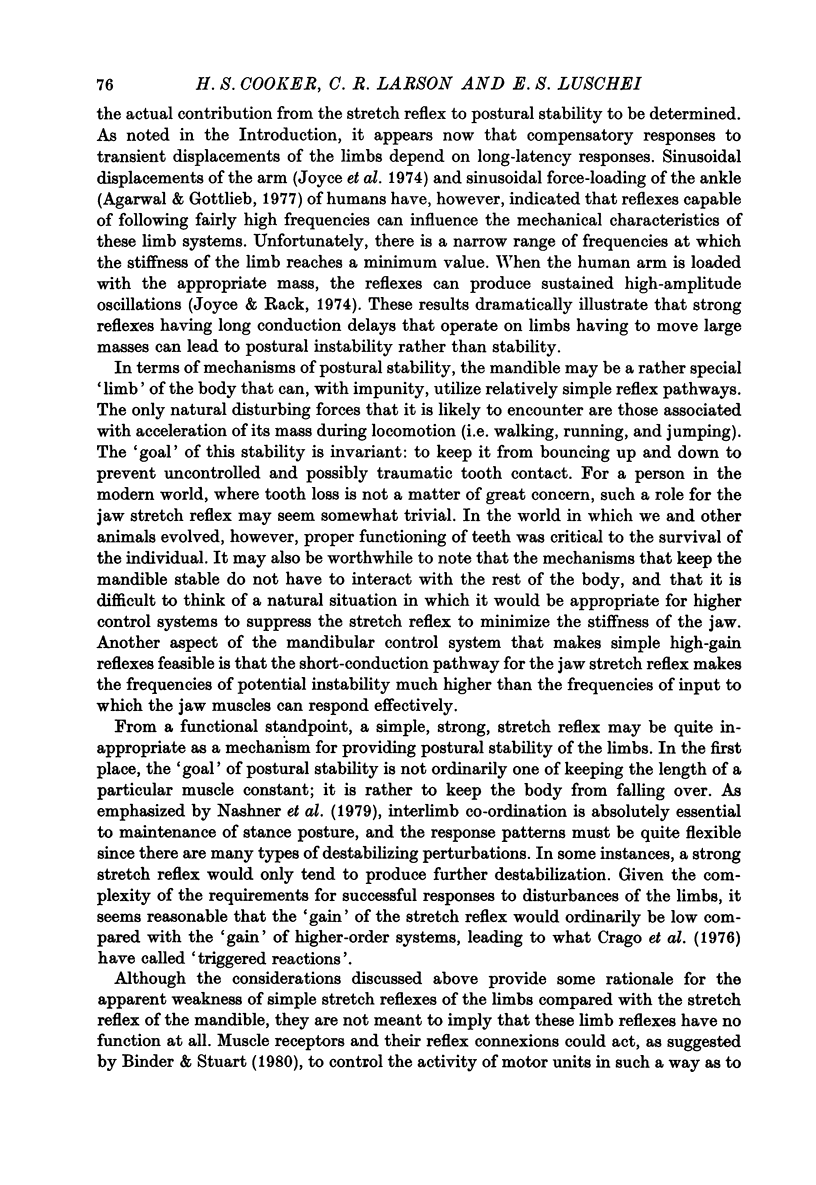
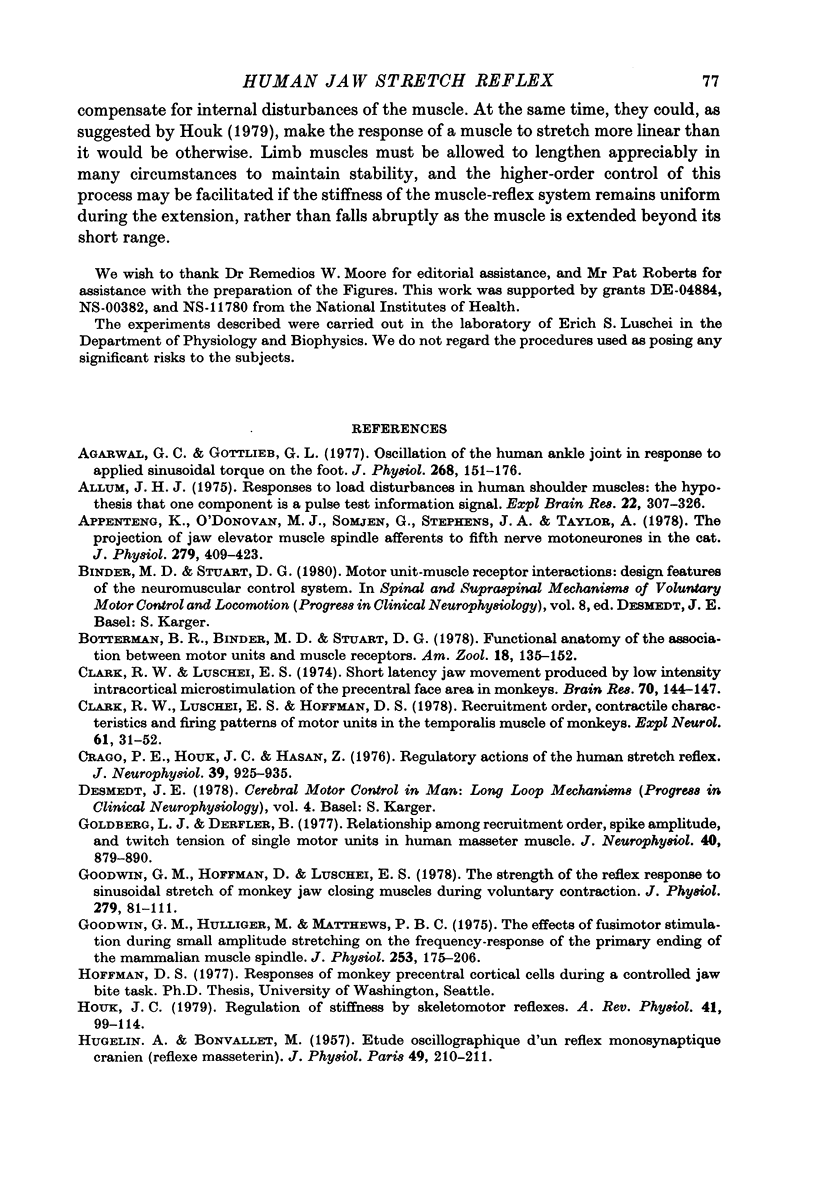
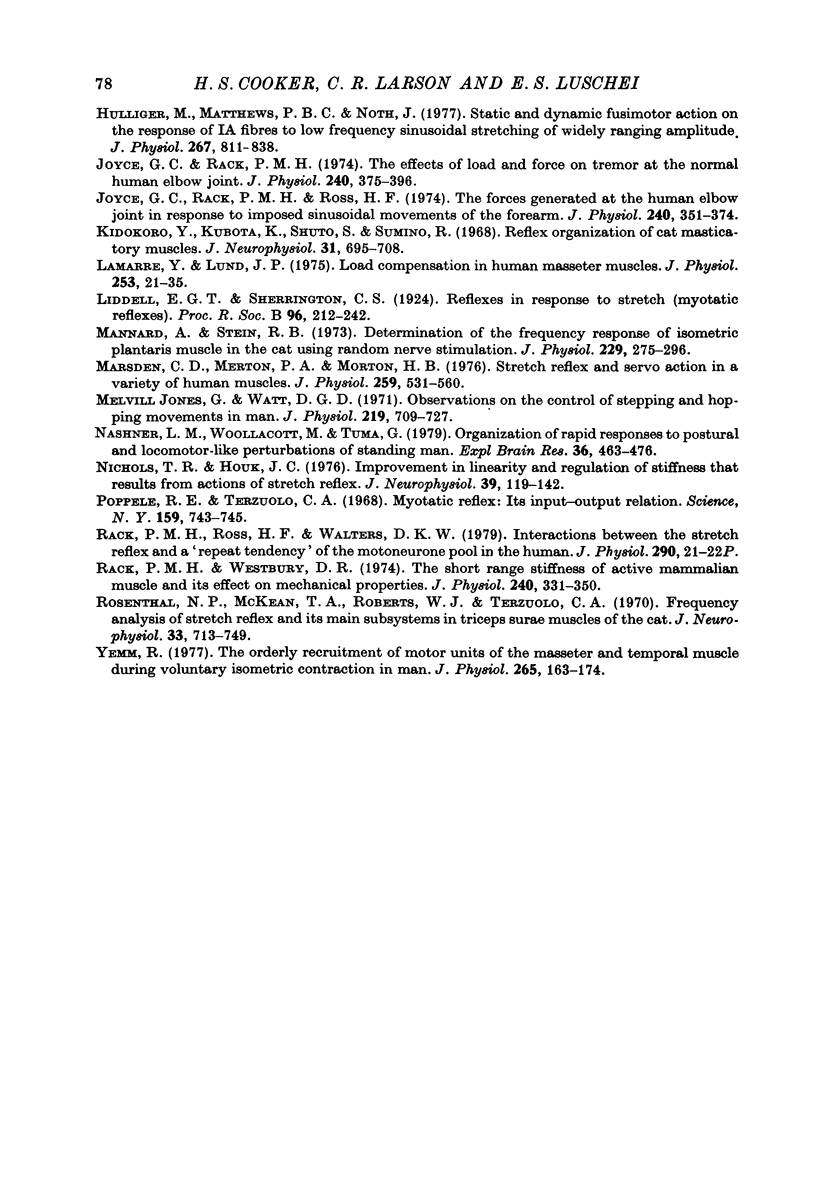
Selected References
These references are in PubMed. This may not be the complete list of references from this article.
- Agarwal G. C., Gottlieb G. L. Oscillation of the human ankle joint in response to applied sinusoidal torque on the foot. J Physiol. 1977 Jun;268(1):151–176. doi: 10.1113/jphysiol.1977.sp011852. [DOI] [PMC free article] [PubMed] [Google Scholar]
- Allum J. H. Responses to load disturbances in human shoulder muscles: the hypothesis that one component is a pulse test information signal. Exp Brain Res. 1975 Mar 27;22(3):307–326. doi: 10.1007/BF00234772. [DOI] [PubMed] [Google Scholar]
- Appenteng K., O'Donovan M. J., Somjen G., Stephens J. A., Taylor A. The projection of jaw elevator muscle spindle afferents to fifth nerve motoneurones in the cat. J Physiol. 1978 Jun;279:409–423. doi: 10.1113/jphysiol.1978.sp012353. [DOI] [PMC free article] [PubMed] [Google Scholar]
- Clark R. W., Luschei E. S., Hoffman D. S. Recruitment order, contractile characteristics, and firing patterns of motor units in the temporalis muscle of monkeys. Exp Neurol. 1978 Aug;61(1):31–52. doi: 10.1016/0014-4886(78)90179-6. [DOI] [PubMed] [Google Scholar]
- Clark R. W., Luschei E. S. Short latency jaw movement produced by low intensity intracortical microstimulation of the precentral face area in monkeys. Brain Res. 1974 Apr 12;70(1):144–147. doi: 10.1016/0006-8993(74)90220-0. [DOI] [PubMed] [Google Scholar]
- Crago P. E., Houk J. C., Hasan Z. Regulatory actions of human stretch reflex. J Neurophysiol. 1976 Sep;39(5):925–935. doi: 10.1152/jn.1976.39.5.925. [DOI] [PubMed] [Google Scholar]
- Goldberg L. J., Derfler B. Relationship among recruitment order, spike amplitude, and twitch tension of single motor units in human masseter muscle. J Neurophysiol. 1977 Jul;40(4):879–890. doi: 10.1152/jn.1977.40.4.879. [DOI] [PubMed] [Google Scholar]
- Goodwin G. M., Hoffman D., Luschei E. S. The strength of the reflex response to sinusoidal stretch of monkey jaw closing muscles during voluntary contraction. J Physiol. 1978 Jun;279:81–111. doi: 10.1113/jphysiol.1978.sp012332. [DOI] [PMC free article] [PubMed] [Google Scholar]
- Goodwin G. M., Hulliger M., Matthews P. B. The effects of fusimotor stimulation during small amplitude stretching on the frequency-response of the primary ending of the mammalian muscle spindle. J Physiol. 1975 Dec;253(1):175–206. doi: 10.1113/jphysiol.1975.sp011186. [DOI] [PMC free article] [PubMed] [Google Scholar]
- HUGELIN A., BONVALLET M. Etude oscillographique d'un réflexe monosynaptique crânien; reflexe massétérin. J Physiol (Paris) 1957 Jan-Mar;49(1):210–211. [PubMed] [Google Scholar]
- Hulliger M., Matthews P. B., Noth J. Static and dynamic fusimotor action on the response of Ia fibres to low frequency sinusoidal stretching of widely ranging amplitude. J Physiol. 1977 Jun;267(3):811–838. doi: 10.1113/jphysiol.1977.sp011839. [DOI] [PMC free article] [PubMed] [Google Scholar]
- Jones G. M., Watt D. G. Observations on the control of stepping and hopping movements in man. J Physiol. 1971 Dec;219(3):709–727. doi: 10.1113/jphysiol.1971.sp009684. [DOI] [PMC free article] [PubMed] [Google Scholar]
- Joyce G. C., Rack P. M., Ross H. F. The forces generated at the human elbow joint in response to imposed sinusoidal movements of the forearm. J Physiol. 1974 Jul;240(2):351–374. doi: 10.1113/jphysiol.1974.sp010614. [DOI] [PMC free article] [PubMed] [Google Scholar]
- Joyce G. C., Rack P. M. The effects of load and force on tremor at the normal human elbow joint. J Physiol. 1974 Jul;240(2):375–396. doi: 10.1113/jphysiol.1974.sp010615. [DOI] [PMC free article] [PubMed] [Google Scholar]
- Kidokoro Y., Kubota K., Shuto S., Sumino R. Reflex organization of cat masticatory muscles. J Neurophysiol. 1968 Sep;31(5):695–708. doi: 10.1152/jn.1968.31.5.695. [DOI] [PubMed] [Google Scholar]
- Lamarre Y., Lund J. P. Load compensation in human masseter muscles. J Physiol. 1975 Dec;253(1):21–35. doi: 10.1113/jphysiol.1975.sp011177. [DOI] [PMC free article] [PubMed] [Google Scholar]
- Mannard A., Stein R. B. Determination of the frequency response of isometric soleus muscle in the cat using random nerve stimulation. J Physiol. 1973 Mar;229(2):275–296. doi: 10.1113/jphysiol.1973.sp010138. [DOI] [PMC free article] [PubMed] [Google Scholar]
- Marsden C. D., Merton P. A., Morton H. B. Stretch reflex and servo action in a variety of human muscles. J Physiol. 1976 Jul;259(2):531–560. doi: 10.1113/jphysiol.1976.sp011481. [DOI] [PMC free article] [PubMed] [Google Scholar]
- Nichols T. R., Houk J. C. Improvement in linearity and regulation of stiffness that results from actions of stretch reflex. J Neurophysiol. 1976 Jan;39(1):119–142. doi: 10.1152/jn.1976.39.1.119. [DOI] [PubMed] [Google Scholar]
- Poppele R. E., Terzuolo C. A. Myotatic reflex: its input-output relation. Science. 1968 Feb 16;159(3816):743–745. doi: 10.1126/science.159.3816.743. [DOI] [PubMed] [Google Scholar]
- Rack P. M., Ross H. F., Walters D. K. Interactions between the stretch reflex and a 'repeat tendency' of the motoneurone pool in the human [proceedings]. J Physiol. 1979 May;290(2):21P–22P. [PubMed] [Google Scholar]
- Rack P. M., Westbury D. R. The short range stiffness of active mammalian muscle and its effect on mechanical properties. J Physiol. 1974 Jul;240(2):331–350. doi: 10.1113/jphysiol.1974.sp010613. [DOI] [PMC free article] [PubMed] [Google Scholar]
- Rosenthal N. P., McKean T. A., Roberts W. J., Terzuolo C. A. Frequency analysis of stretch reflex and its main subsystems in triceps surae muscles of the cat. J Neurophysiol. 1970 Nov;33(6):713–749. doi: 10.1152/jn.1970.33.6.713. [DOI] [PubMed] [Google Scholar]
- Yemm R. The orderly recruitment of motor units of the masseter and temporal muscles during voluntary isometric contraction in man. J Physiol. 1977 Feb;265(1):163–174. doi: 10.1113/jphysiol.1977.sp011710. [DOI] [PMC free article] [PubMed] [Google Scholar]


